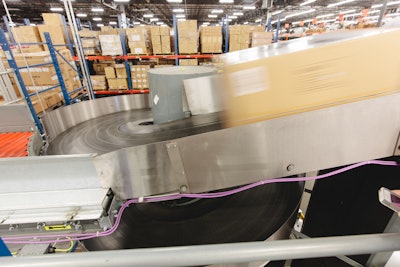
“We are living in a time-sensitive click-and-ship marketplace, yet many retailers still find themselves scrambling to optimize their omnichannel strategies,” laments Matt Clark, COO of Corcentric, an accounts payable solutions firm.
While in many cases his statement rings true, the results of the annual retail industry benchmark report issued by SPS Commerce shows the tides are starting to shift. “Respondents report 200 percent year-over-year growth in their omnichannel initiatives, which shows retailers are finally making change happen,” says Peter Zaballos, senior vice president and chief marketing officer for the electronic data interchange (EDI) provider.
“There is a decreased emphasis on product availability in stores,” he adds. “Because retailers are moving forward on cross-channel fulfillment, their sales no longer solely depend on their ability to stock shelves. The holy grail is now rapid order fulfillment with consumers in the driver’s seat.”
The SPS study highlights that more retailers are jumping into the omnichannel sea. However, Home Depot has been swimming in the retail channel-infested waters a bit longer. The do-it-yourself (DIY) home repair giant invests in a host of deployments that give consumers what Stephanie Smith, vice president of direct fulfillment and delivery, calls an interconnected retail experience.
She explains, “Omnichannel is really how a retailer looks at supply chain, but interconnected considers how we want consumers to see our environment. [In its omnichannel/interconnected retail efforts], Home Depot seeks to integrate the store experience and the online experience from a customer perspective.”
The retailer’s integrated view also applies to its entire supply chain, Smith adds, noting, “We need a global view of all of our inventory and fulfillment channels, and a global view of our transportation assets, to make sure-from an interconnected perspective-we are making the best decisions to support our customers.”
The company’s e-commerce investment, which included deploying a chainwide customer order management (COM) system and launching a buy-online-deliver-from-store (BODFS) initiative, is paying off. The retailer saw more than a 21 percent increase in online sales in 2016.
“We continue to see great productivity from our supply chain as dividends from investments made over the last several years yield a positive impact on our inventory productivity, logistics costs, and service to our stores and customers,” Home Depot Chairman Craig Menear told Diginomica in 2016.
An Evolving Solution
“Omnichannel is really multichannel selling,” says Nick Manzo,global omnichannel lead at 1WorldSync, an international company managing a multi-enterprise product information network.
And, for it to work, Pan Chen, vice president of analytics and supply chain services at HAVI, a supply chain management consultancy, states the customer experience needs to be consistent; consumers expect to access the same products and have the same brand experience across channels.
“No matter how customers view a brand, they want that same core value,” explains Hank Canitz, director of product marketing and business development for Logility, a company that offers supply chain management software.
For this to occur, Manzo says companies must fully define their omnichannel approach. He explains that omnichannel strategies take different shapes depending on whether the company is an e-commerce organization versus a brick-and-mortar operation. They also are affected by the selling platforms that already exist and the ones they hope to develop. He adds that companies must focus on identified channels first, build those strategies and garner success, before moving on to the next project.
“Each area of channel-based engagement requires a different skillset, different understanding and different prioritization,” he says.
For this reason, Home Depot took a phased approach to its interconnected strategy, says Smith. The company began in 2011 with its buy-online-return-in-store (BORIS) process, then added buy-online-pickup-in-store (BOPIS), as well as buy-online-and-ship-to-store (BOSS). In 2016, it added the BODFS option.
The company’s omnichannel efforts also include its Supply Chain Synchronization Project (Sync), which enables workers to see the products on every inbound truck. It is hoped that Sync will grow inventory turns from 4.8 times in 2015 to a targeted 5.7 times by 2018. The company’s COM system, which is live in 2,000 U.S. retail stores, also plays a role by enabling employees to track where an order is in the manufacturing and delivery process.
Home Depot also built three direct fulfillment centers in strategic locations—one outside of Atlanta; one in Troy Township, Ohio; and a third in Perris, California. Products from these facilities can reach 90 percent of the United States within two days, which Smith says helps the company fulfill its delivery speed promise.
It’s safe to say you can’t have one of these capabilities without the other—at least as far as Home Depot is concerned.
Smith explains, “[For omnichannel to be successful], you need a vision of where you want to be and then it’s really an evolution. Customers want to shop the way they want to shop and when they want to shop, and they want to get product when they want to get it. It’s all about offering a variety of options for the customer, whether that’s going and picking up things in the store that the customer ordered online, purchasing things online and having them delivered directly to your home, or shipping from the store.”
Shut Down Siloes
Omnichannel evolved in a siloed fashion; companies began with brick-and-mortar stores, then added a website, kiosks, mobile and more. “Because these channels have grown up independently, they’ve been siloed and customers are not recognized across all of them,” says David Dorf, vice president of product strategy at Infor, an enterprise software company. “Omnichannel is an effort to unite the customer experience across all channels.”
He explains a customer should be able to put products into a virtual cart online, switch to a mobile phone and still see the cart, and later pull up this cart to locate those products in a brick-and-mortar store. “We call that the endless aisle,” he says. “If you go into a store and you can’t find what you’re looking for, it should be easy to order it online and have it shipped to your home [and vice versa]. The retailers that can do this will save the sale.”
In practice, however, this is not always a reality.
Jim Prewitt, vice president of retail industry strategy for JDA Software Group, which offers software solutions for the supply chain, states: “Most companies keep their channels separate. They keep their planning and inventory separate, and they keep their fulfillment processes separate for those channels.”
Further complicating matters is the fact that omnichannel efforts often involve disparate pieces of software that do not communicate well with each other. A retailer might operate a point-of-sale system from Oracle, but run SAP Order Management on the back-end, then employ another vendor’s software for its e-commerce site. “They have three different vendors, three different databases and a ton of integration going on behind the scenes to make it work,” Dorf says.
Transform with Technology
Software tools can help companies see their customers and their buying histories to fully understand their preferences in order to turn every transaction into a more customer-centric one. “Companies need a single selling platform that serves all of their channels. With this, there is no integration, no movement of data. There is one set of data, which also makes it easier to keep inventory accurate, make fulfillment decisions and maintain a single customer record,” Dorf says.
An integrated platform provides visibility into the entire inventory, but Canitz laments, “I think retailers are a little bit behind.”
According to Clark, retailers still need to automate back-end processes. “To do so, they need to move to single-source solutions and suites that can support processes from end to end.
Transparent data can help buyers and suppliers at all ends of the supply chain arm themselves for a strong omnichannel strategy,” he adds.
Though technology can optimize omnichannel, Smith cautions, “You don’t just implement one system and then you have a complete omnichannel view. It’s something that has to be integrated into the fabric of the entire supply chain. At Home Depot, it’s in our inventory systems, it’s in our transportation systems, it’s in our order management systems. They all need visibility.”
Integrate Thy Inventory
“The No. 1 pain point when it comes to omnichannel today is inventory accuracy,” states Dorf. “Theft, mislabeling products, putting them in the wrong places and accepting shipments that are not complete all contribute to this. Then what happens is [retailers] make promises to customers, such as: ‘I’m going to ship this to you by this date,’ but ‘oops, I’m really out of stock,’ or ‘I’m going to hold this for you in the store,’ but ‘oops, the store can’t find it.’ ”
The software companies use must be able to track when discrepancies in inventory occur. If a particular region has a lot of accuracy issues, it needs to find out why. Maybe the store or distribution center isn’t stocked well or additional loss prevention efforts are needed. “It could be any number of things,” says Dorf. “A lot of companies are looking at using RFID to improve inventory accuracy.”
When there are multiple locations, such as brick-and-mortar stores, store distribution centers and direct fulfillment distribution centers, Smith says inventory ordering systems must be able to forecast demand through every channel, then fulfill demand through the correct location. “It’s really about accurate forecasting and then fulfilling an order based on that, which means we need a view of inventory by every single location available,” she says.
Home Depot also operates a centralized inventory replenishment system that manages replenishment inventory for stores and distribution centers, and provides employees with a global view of inventory. This system loads inventory information into the company website, so that if customers look there for a specific product, they can see how many are in stock and where.
This system also provides inventory information to store associates who are equipped with FIRST Phones, which are ruggedized smartphones they can use to obtain detailed inventory information for customers.
Focus on Fulfillment
“Omnichannel is all about Big Data and making good decisions based on the analytics. It’s a big math problem depending on where your vendor locations are, where your customers are located and what types of trucks are available,” says Smith. “Home Depot employs analytics teams that are focused on these types of decisions.”
This team sets business rules in its software that enable the tool to offer different fulfillment options that ensure parcel ground product within two days. If customers need something the same day or next day, the site informs them that the best place to go is a store. “Something like lumber can only come from our stores,” Smith explains. “The system facing the customer gives multiple options if there are multiple fulfillment options available. However, in some cases, there is only one option of where we can fulfill from. It’s determined by a combination of factors, including the size of the product, the speed to the customer, the cost of shipping and so on.”
Every parameter is set down to the item level, based on what makes the most sense and where it is stocked. “We sell over 1 million products online at Home Depot and we carry a number of different products at different points in the year in our direct fulfillment centers, but they can hold up to 100,000 products, which is a small percentage of the total products that we sell,” Smith says.
Intelligent fulfillment decisions need to happen quickly and seamlessly. “If somebody buys something online, the software needs to determine if it is best to ship from a nearby warehouse or if the product should be shipped from the store,” Dorf says. “If it’s a store, which store should it be shipped from? Should it ship from the closest one or from the store that is selling the fewest of the item to get rid of that inventory? Or should the product be drop-shipped directly from the vendor?”
Dorf says companies are getting more sophisticated with automating decisions by setting business rules within their software tools. They may decide that getting the most margin out of the sale is most important, or they may decide that customer service and loyalty is most important. “If it’s the latter, they may pick the closest store to get it shipped to that customer very, very quickly,” he says. “There are different levers they can chose from to make sure they’re satisfying the customer in whatever way they think is best.”
As companies ride the waves in an omnichannel sea, examples set by leaders like Home Depot can keep them afloat in their quest to meet the needs of customers in the time-sensitive click-and-ship retail world.

















![Pros To Know 2026 [color]](https://img.sdcexec.com/mindful/acbm/workspaces/default/uploads/2025/08/prostoknow-2026-color.mduFvhpgMk.png?ar=16%3A9&auto=format%2Ccompress&bg=fff&fill-color=fff&fit=fill&h=135&q=70&w=240)